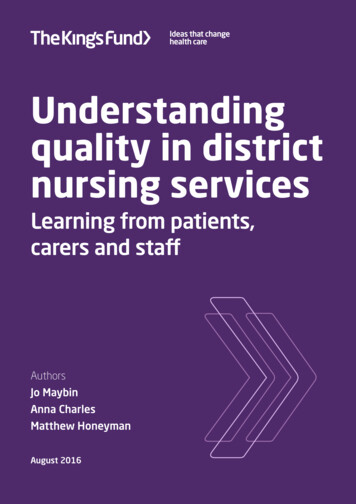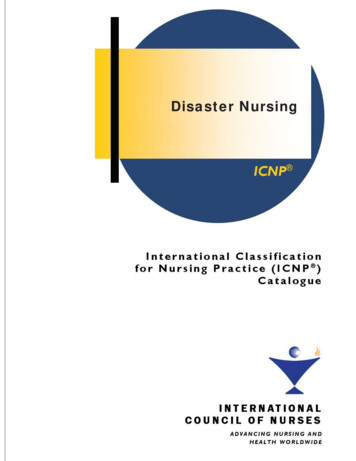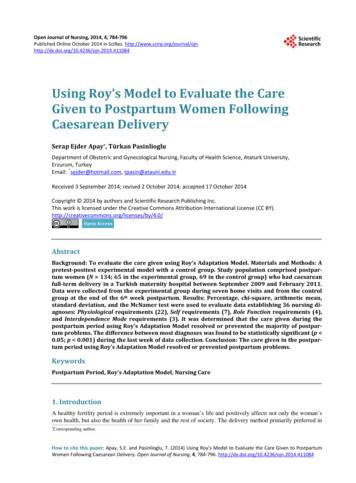
Transcription
Understandingquality in districtnursing servicesLearning from patients,carers and staffAuthorsJo MaybinAnna CharlesMatthew HoneymanAugust 2016
Understanding quality in district nursing services123456ContentsKey messages31Introduction52Background7District nursing services73Demographic changes and the policy drive to shift care closerto home10Managing quality in district nursing services11What is ‘good care’?14A quality framework for district nursing14Caring for the whole person15Continuity of care19The personal manner of staff23Scheduling and reliability of appointments25Being available for patients and carers to contactbetween appointments27Valuing and involving carers and family members28Nurses acting as co-ordinators and advocates32Clinical competence and expertise34Patient education and support for self-management36Contents 1Contents 1
Understanding quality in district nursing services145623456What can this model of care achieve?40Is ‘good care’ consistently being delivered?41Pressures in district nursing42What gets in the way of ‘good care’?42How are services responding to the demand—capacity gap indistrict nursing?52What is the impact on staff wellbeing and the quality and safetyof care?55What does this mean for district nursing care?66Discussion67The demand–capacity gap: the impact on staff wellbeing andrisks to the quality and safety of patient care67Knowing when patient care is being damaged70Recommendations72Appendix: Methodology76References81About the authors90Acknowledgements91Contents 2
Understanding quality in district nursing services123456Key messagesDistrict nursing services provide a lifeline for many people and play a key role inhelping them to maintain their independence, manage long-term conditions andtreat acute illnesses. At their best, they deliver an ideal model of person-centred,preventive and co-ordinated care, which can reduce hospital admissions and helppeople to stay in their own homes.Although limitations to national data make it difficult to establish a robust accountof changes to activity and staffing, there is evidence of a profound and growing gapbetween capacity and demand in district nursing services. Our research, together with national surveys, indicates that activity hasincreased significantly over recent years, both in terms of the number ofpatients seen and the complexity of care provided. While demand for services has been increasing, available data on the workforceindicates that the number of nurses working in community health services hasdeclined over recent years, and the number working in senior ‘district nurse’posts has fallen dramatically over a sustained period.Our research suggests that these pressures are compromising quality of care. Wefound examples of an increasingly task-focused approach to care, staff being rushedand abrupt with patients, reductions in preventive care, visits being postponed andlack of continuity of care.This is having a deeply negative impact on staff wellbeing, with unmanageablecaseloads common and some leaving the service as a result. We heard of staff being‘broken’, ‘exhausted’ and ‘on their knees’.It is worrying that the people most likely to be affected by this are often veryvulnerable and among those who are also most likely to be affected by cuts in socialcare and voluntary sector services. It is even more troubling that this is happening‘behind closed doors’ in people’s homes, creating a real danger that serious failuresin care could go undetected because they are invisible.Introduction 3
Understanding quality in district nursing services123456District nursing shortages risk adding to pressures on other parts of the health andcare system: other recent research by The King’s Fund has found this is already havingan impact on caseloads in general practice and social care. There is also a risk of thiscontributing to the growing number of older people requiring acute hospital admission,and to delayed transfers of care for older people being discharged from hospital.The dissonance between the frequently stated policy ambition to offer ‘more careclose to home’ and the apparent neglect of community health services over recentyears is striking. Resources, monitoring and oversight remain stubbornly focused onthe acute hospital sector.We suggest the following as immediate priorities to address the issues revealed inthis report: system leaders must recognise the vital strategic importance of communityhealth services in realising ambitions for transforming and sustaining thehealth and social care system there is an urgent need to create a sustainable district nursing workforce byreversing declining staff numbers, raising the profile of district nursing anddeveloping it as an attractive career robust mechanisms for monitoring resources, activity and workforce must bedeveloped alongside efforts to look in the round at the staffing and resourcingof community health and care services for the older population.It is also essential to develop a robust framework for assessing and assuring thequality of care delivered in community settings. Our research suggests that staff,patients and carers have a strongly aligned set of beliefs about the components of‘good’ district nursing care, valuing a ‘whole-person approach’ to care with a focuson relational continuity, involvement of family and carers, patient education andself-management support, and care co-ordination. This would provide a strongfoundation for developing a new quality framework suited to the distinctivecharacteristics of this care.Key messages 4
Understanding quality in district nursing services1123456IntroductionDistrict nursing services are a vital part of the NHS for many people, often makingthe difference between people being able to stay well at home or moving intoresidential care settings. A growing older population and related increases in theprevalence of frailty and long-term conditions, together with a policy ambition toshift more care out of hospitals and into community settings, mean that districtnursing is a key part of the health service both now and in the future (Ham et al2012).However, we know very little about demand for district nursing services nationally,what capacity there is within the workforce, what level and type of care is providedand still less about the quality of this care. The distinctive features of district nursingcare, particularly the fact that it happens ‘behind closed doors’ in people’s homes,make most existing quality measures used in the hospital sector a poor fit andscrutiny a real challenge.This study focused on care for older people who receive district nursing services intheir own homes. It asked the following questions. What does good-quality care look like in this context from the perspective ofpeople receiving care, their carers and district nursing staff? How does that compare to their experiences? What factors support ‘good care’, and what is getting in the way?To answer these questions, we: conducted a review of existing policy and research literature had scoping conversations with national stakeholders conducted focus groups with senior district nursing staff (n 40) carried out interviews with patients, carers and staff in three case study sites(n 50).Introduction 5
Understanding quality in district nursing services123456Each ‘site’ was the area covered by one district nursing service. (For details see theAppendix.)While our work was originally focused on drawing together evidence to set out aframework for understanding the quality of district nursing care, during the courseof our research we found evidence of a profound gap between demand and capacitywithin district nursing services. Moreover, we identified concerning evidence ofthe impact this was having on staff wellbeing and on the quality and safety of caredelivered to patients. Therefore, we present the findings of this report in two parts. The first part sets out our framework for what ‘good care’ looks like in districtnursing services, providing an evidence-based foundation to inform qualityassurance and improvement work by frontline teams, provider organisations,commissioners and regulators. The second part outlines evidence of the demand–capacity gap in our casestudy sites – together with national data indicating that this is a much widerproblem – and sets out examples of the ways in which this is damaging staffwellbeing, and pulling care away from the features of good-quality careoutlined in our framework.Introduction 6
Understanding quality in district nursing services1223456BackgroundDistrict nursing servicesDistrict nursing services deliver a wide range of nursing interventions to peoplein their own homes (see the box below) and play a key role in supportingindependence, managing long-term conditions and preventing and treating acuteillnesses. These services are required for many reasons, but are commonly needed bydisabled adults, older people living with frailty and long-term conditions, and thosewho are near the end of their life (Cornwell 2012; Imison 2009). According to the mostrecent NHS reference costs release for 2014/15 (containing data from just over half oftrusts), approximately 20 per cent of NHS spending on community health serviceswas spent on district nursing (about 2 per cent of the total NHS budget) (Departmentof Health 2015).Services commonly provided by district nursing services Advice and support Bowel care Continence management End-of-life care General nursing care Health education Injections (intramuscular/intravenous/subcutaneous) Intravenous therapy, including chemotherapy Medication administration Medication reviews Monitoring/screening Nasogastric (NG) tube feeding (artificial feeding through a tube inserted into the nose)Background 7
Understanding quality in district nursing services123456 Pain control Percutaneous endoscopic gastrostomy (PEG) feeding (artificial feeding through a tubeinserted directly into the stomach) Phlebotomy (blood taking) Prescribing Pressure area care (to prevent the development of pressure ulcers) Referral to other services Risk assessment Skin care Urinary catheterisation and ongoing catheter care Wound careSource: Adapted from The Queen’s Nursing Institute 2009The terminology used for these services is not always consistent; the terms‘community nursing services’ and ‘district nursing services’ are often usedinterchangeably. For the purposes of this report, we use the term ‘districtnursing services’ to distinguish these services from nursing care in other areasof community services.Definitions of ‘community nurse’ and ‘district nurse’ are outlined in the boxbelow; however, again, these terms are also often used interchangeably in practice.Throughout this report, we refer to qualified nurses working in district nursingteams as ‘community nurses’ (who include some staff with a district nursingspecialist practitioner qualification), and to senior frontline staff with team leaderroles as ‘district nurse team leaders’. We refer to other staff working in these teams,including health care assistants and assistant practitioners, as ‘support staff ’.Background 8
Understanding quality in district nursing services123456Staff who commonly work in, or closely with, district nursing servicesCommunity nurse – a registered nurse working in the community with or without aspecialist practitioner qualification. Registered nurses work at varying levels of senioritywithin community teams, depending on their level of experience and pay banding. It ispossible for nurses without the district nursing qualification to hold management positions.District nurse – a registered nurse with a district nursing specialist practitionerqualification recordable with the Nursing & Midwifery Council. The specialist practitionerqualification focuses on topics including: case management; clinical assessment skills; careco-ordination; autonomous decision-making; advanced clinical skills; leadership and teammanagement. These nurses often hold senior or management positions within communitynursing teams. In practice, the term ‘district nurse’ is often used to refer to nurses workingin district nursing teams who do not have a specialist practitioner qualification, but occupya ‘district nurse’ post.Nursing support staff or health care support workers – staff working in clinical rolesin district nursing teams who are not registered nurses, for example health care assistantsand assistant practitioners.Community matron – introduced in 2004, the community matron role combines advancedclinical practice with active case management. Community matrons work to improve thecare of people living with long-term conditions in the community through: education,support for self-management, close surveillance and co-ordination of health and social careservices. Community matrons often work with patients with multiple long-term conditionsand complex needs.Clinical nurse specialist – an advanced practitioner with expertise in a particular conditionor set of conditions. Clinical nurse specialists may work in acute or community settings, theymay visit patients at home and they may offer support and advice to community nursingteams. Specialty areas include: tissue viability, continence, palliative care, chronic obstructivepulmonary disease and heart failure.A survey of Royal College of Nursing (RCN) members working in district nursingservices found that a ‘typical’ district nursing team covers a population of slightlymore than 5,000 people and includes: two district nurses five registered nurses (without a district nursing qualification)Background 9
Understanding quality in district nursing services123456 one community matron two health care assistants/other support workers one member of clerical/administrative staff 0.5 ‘other’ staff.This survey found that, on average, 75 per cent of staff in community nursing teamswere registered nurses, 17 per cent were band 1–4 health care support workers and6 per cent were administrative and clerical staff. The survey also revealed significantvariation; for example, 43 per cent of teams had no community matrons, 38 per centhad no administrative or clerical staff and 16 per cent had no district nurses (Ball etal 2014).There is also significant variation in the organisational configuration of districtnursing services (and all other community health services) following theTransforming Community Services policy (Foot et al 2014; Lafond et al 2014): some are provided by standalone community NHS trusts some are provided by combined community and acute or mental health trusts some are provided by charities, social enterprises or private sector providers.(For a potted history of the frequent reforms to and restructuring of communityhealth services, see Foot et al 2014 and The Queen’s Nursing Institute 2009.)Compared with other areas of NHS care, the independent sector is now a significantprovider of NHS-funded district nursing and other community health services. In2012/13, 69 per cent of NHS spending on community health services went to NHSproviders, 18 per cent to the independent sector and the remaining 13 per cent tosocial enterprises and voluntary organisations – this compared with the acute hospitaland mental health sectors, where the proportion of 2012/13 spending that went toNHS providers was 96 per cent and 81 per cent respectively (Lafond et al 2014).Demographic changes and the policy drive to shift care closer to homeThe nature of the care provided by district nursing services, and the fact that theseservices are usually reserved for patients who have difficulty leaving their home,Background 10
Understanding quality in district nursing services123456means that a large proportion (but not all) of the people who receive this care areolder patients living with multiple complex long-term conditions, limited mobilityand frailty.Between 2005 and 2014, the number of people in England aged 65 and overincreased by almost a fifth, with the most marked growth in the oldest age groups;in the same time period, the population aged 85 and over increased by just under athird. This trend is predicted to accelerate; from 2015 to 2035, the number of peopleaged 65 and over is expected to increase by almost half and the number aged 85 andover to almost double (Mortimer and Green 2015; Office for National Statistics 2015). Aspeople age, they are increasingly likely to live with chronic disease, multiple healthconditions, disability and frailty (Health and Social Care Information Centre 2014; Oliveret al 2014).An important policy response to these demographic changes has been an ambitionto shift more care for older people out of hospitals and into community settings,including into people’s own homes (Edwards 2014). In recent policy history, thisdrive dates back 10 years to the 2006 White Paper Our health, our care, our say(Department of Health 2006) and has taken various forms, including: runningoutreach clinics from hospitals; up-skilling primary care doctors and nursesto undertake more specialist work in the community; and more pro-activelyidentifying and supporting people living with long-term conditions who may be atrisk of hospitalisation.Providing care in the community rather than in hospitals has been seen as a way ofboth improving patients’ experiences of care and also reducing pressure on hospitalsand costs to the taxpayer. The evidence for whether these aspirations are realised inpractice is mixed (Monitor 2015), but the policy direction is clearly set, most recentlyby the NHS five year forward view, which promised ‘far more care delivered locally’(NHS England et al 2014). This might lead us to expect an expansion in these servicesin terms of the available funding and workforce; however, in recent years this hasnot been the case (Addicott et al 2015).Managing quality in district nursing servicesCompared with data on care delivered in hospitals, relatively little data oncommunity health services is collected and collated at a national level. In the caseBackground 11
Understanding quality in district nursing services123456of hospital care, every patient episode has been recorded and collated nationallysince the development of Hospital Episode Statistics in the late 1980s, but there isno equivalent, nationally mandated, data collection on activity in community healthservices. However, work is ongoing to develop the Community Information DataSet (CIDS). Similar to Hospital Episode Statistics, this is intended to provide robust,comprehensive, nationally consistent and comparable, patient-level informationfor community services (Health and Social Care Information Centre 2016b). The CIDSis currently in use for local data collection and extraction; it remains unclear whennational collection and publication of this data will be realised.There is also much less information available on the quality of care provided incommunity settings, including the nature of patient and carer experiences of thatcare. A previous report by The King’s Fund on managing quality in community healthservices (Foot et al 2014) described the limited range of national and local qualitydata that is collected in this area and summarised some of the particular barriers todeveloping a more robust information base for community services, including: the diversity of services provided by the community care sector the large number of service providers the multiplicity and complexity of data flows required to cover the numerousand diverse services, settings and client base covered by community care the comparatively weaker information infrastructure in community carecompared with the primary care and hospital sectors where informationtechnology is better developed intrinsic difficulties in monitoring the quality of care provided in people’s ownhomes.A limited number of the quality measurement and assurance systems that apply tohospital care also apply to district nursing care, some of which focus on patient and/or staff experience. These include: the Friends and Family Test, which asks patients to give their views on the NHScare or treatment they have received Care Quality Commission inspectionsBackground 12
Understanding quality in district nursing services123456 the Commissioning for Quality and Innovation (CQUIN) framework, whichrewards health care providers for achieving local quality improvement goals NHS complaints data incident reporting the NHS Safety Thermometer, a tool to measure whether patients are at risk ofharm in the care environment the annual NHS Staff Survey.Commissioners and provider organisations also collect data at a local level, whichthey may or may not make available, for example through their quality accounts.Other initiatives to collect data on community health services include the following: the national indicator development project for community services – thisis funded by a group of providers with the aim of developing a range ofmeaningful quality metrics for community settings, with an emphasis onpatient-reported outcome measures and experience the NHS Benchmarking Network – this is a member-led organisation thatcollects data from some 80 per cent of NHS community service providers,including information on activity, funding, the workforce, access to care andthe quality of care (Foot et al 2014).The national NHS patient experience survey programme does not extend topeople receiving district nursing care in their home. However, the Care QualityCommission (2016) is currently consulting on extending the programme tocommunity services.Background 13
Understanding quality in district nursing services1323456What is ‘good care’?A quality framework for district nursingThis section sets out a framework for understanding the components of ‘good care’for older people receiving care from district nursing services in their own home.The framework is derived from interviews with people receiving district nursingcare, their unpaid carers and staff; and focus groups with staff. It is supplementedwith findings from our review of the literature. Our analysis most often drew ondiscussions of positive experiences and the values and preferences of interviewees,but it sometimes also drew on discussions of negative care experiences and what thehypothetical inverse of these would look like.The strongest message we heard from older people receiving care from districtnursing services and their unpaid carers was one of gratitude. Although there wasa considerable range in the severity and complexity of the health conditions theseolder people and their families were living with, most of the people receiving carewere unable to leave the house independently and some had not left their homeexcept in medical emergencies for some years. It is difficult to overstate the valuethat our interviewees placed on having health professionals visit them to providethe care that they needed, helping them to continue to live at home rather than to becompelled to move to a hospital or a care home.The first three characteristics of good care that were most commonly described, andoften the most intensely felt, by all three interviewee groups were: caring for the whole person continuity of care the personal manner of staff.In addition, people receiving care and their carers spoke of: the importance of visit times being predictable and reliable being able to contact services between appointment times.What is ‘good care’? 14
Understanding quality in district nursing services123456Additional characteristics that were important to all participants, but to a lesserdegree, were: valuing and involving carers and family members nurses acting as co-ordinators and advocates clinical competence and expertise.Staff also emphasised the importance of their role in supporting and educatingpatients to manage their own health and care needs. The subsections that followoutline the features of each of these characteristics in detail.At their best, district nursing services can offer a model of co-ordinated, personcentred, prevention-oriented community care. They exemplify the principles ofgood care for people living with long-term conditions described by national policyleaders in the NHS five year forward view (NHS England et al 2014) and the recentnursing and midwifery strategy Leading change, adding value (NHS England 2016), aswell as in consensus documents from patient organisations such as the RichmondGroup of Charities (Foot and Maybin 2010).The three characteristics of good care, caring for the whole person, continuityof care and personal manner of staff, described below, were the features mostcommonly described, and often the most intensely felt, by all three interviewee groups.Caring for the whole personWhat does this involve? Taking a holistic, person-centred approach to care rather than a task-focused approach Seeing the person, not the need Considering the person’s other health conditions, social issues and widercircumstances, not just a particular conditionQuality of care improves because: The root cause of a problem can be understood and addressedWhat is ‘good care’? 15
Understanding quality in district nursing services123456 Undiagnosed health problems, including acute illness, can be identified Care can be adapted to the person’s needs, helping to put them at ease The person receiving care and their carer feel supported Care is an important source of social interaction for the person receiving careWho is it a priority for? Older people receiving care Informal carers StaffGood care was commonly described in terms of staff caring for the whole person andproviding holistic, person-centred care rather than taking a task-focused approach.Our participants described a number of key benefits and gave examples, and thesewere very similar for patient and staff interviewees. They included the following. The root cause of a problem can be understood and addressed.I had a patient that had a leg ulcer that wouldn’t heal. We tried everything. AndI was just starting, so I was still very task-oriented. So I would go in do the legand leave. But it got to the point that I started saying to myself, ‘Why is that nothealing, what’s happening?’ So I spoke with her The wounds kept opening,because she was alone, and she was trying to reach a top cupboard and everytime she had to prepare her meals, she would re-open the wound. So, it was such asimple thing. I just had to go into the kitchen, remove the stuff that was up high, Italked with her, and we put it lower The wounds got better you just need to sitdown and talk.(District nurse team leader) Undiagnosed health problems, including acute illness, can be identified.A number of people receiving care and their carers gave examples of occasionswhen their nurse had observed that they were unwell and had arranged furthermedical attention. Examples included an individual with early pneumonia,another with early signs of deep vein thrombosis (DVT) and another who hadfallen and sustained a head injury. These individuals all went on to receiveinvestigations and treatment from their general practitioner (GP) or in hospital,What is ‘good care’? 16
Understanding quality in district nursing services123456and all reported that they would not have sought medical attention without thesupport of their nurse. Care can be adapted to the person’s needs, helping to put them at ease.I went to administer medication to a very confused lady she lives with herdaughter but her daughter was out of the house at that point So my poppingin to give her an injection was very scary [for her] I ended up having to stayhalf an hour instead of 15 minutes, just to calm her down. Because I don’t believein just administering medication without having the patient’s total consent she explained that she was very stressed, because I looked too young to be givinginjections. So after that, I managed to calm her down, explaining to her what theinjection was for, and why she needed it. She calmed down, she understood, so Iwas able to give the injection.(Community nurse) The person receiving care and their carer feel supported.They just seem to go that little bit further to help, I mean, just being asked: ‘Areyou feeling okay?’(Male patient, 60s) Care is an important source of social interaction for people receiving care,particularly those experiencing loneliness and social isolation.The social aspects of the care often appeared to be valued more than its clinicalcomponents:They’re always social. You can talk to them, like I’m talking to you. And I lookforward to them coming They come twice a week at the moment and they’llscale that down to once and then out I dread them signing me off.(Male patient, 90s)Loneliness is one of the problems. So if you spend time talking to [people youare caring for], even five minutes makes a difference to them And the moreyou talk to them, that’s when they also open up and tell you some thingsthat you don’t know they’re in the house, housebound, they don’t get thatsocialising from their family. So the more you walk in there, spend five, tenminutes, spend time, talk to them, you’ll bring them back where they are.(Support staff)I think it’s just the time we spend with them not administering the medication, or doing the wound care. It’s just being with them, and knowing that theyWhat is ‘good care’? 17
Understanding quality in district nursing services123456have some support; someone that will be coming in and checking on them, andmaking sure that they’re safe They’re not so socially isolated They havesomething to aim for, when they wake up in the morning. There is a change intheir day.(District nurse team leader)Caring for the whole person requires professionals to engage with people receivingcare as individuals with a collection of problems, prefer
A survey of Royal College of Nursing (RCN) members working in district nursing services found that a 'typical' district nursing team covers a population of slightly more than 5,000 people and includes: two district nurses five registered nurses (without a district nursing qualification)










